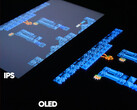In the video embedded below, handheld specialist The Phawx shows what the Steam Deck OLED display looks like after a 750-hour stress test, in which both SDR brightness of up to 400 nits and HDR peak brightness of 1000 nits were tested, in addition to the individual red, green and blue subpixels.
This test is an absolute worst-case scenario, as the content of the screen was never changed over the course of 750 hours, i.e. around 31 days; users who allow their panels to display varied content can naturally expect a longer screen life. However, it is common in games for certain menu elements to be visible almost constantly, such as a life bar, so burn-in or permanently visible afterimages could become a problem in practice on gaming handheld
The results are hardly surprising: "real" burn-in, i.e. content burnt into the panel, is not visible. However, the brightness of pixels subjected to greater stress decreases so much during the test period that, especially when displaying HDR content at maximum brightness, very visible afterimages remain that can no longer be removed. SDR content, on the other hand, does not leave any afterimages that are visible during normal gameplay.
This is mainly because the pixels are subject to less strain at lower brightness levels and less waste heat is generated due to the power consumption of 2 watts in SDR instead of 5 watts in HDR. Hence, those who want their Steam Deck OLED to last as long as possible without replacing the display should reduce the screen brightness slightly.


 Deutsch
Deutsch English
English Español
Español Français
Français Italiano
Italiano Nederlands
Nederlands Polski
Polski Português
Português Русский
Русский Türkçe
Türkçe Svenska
Svenska Chinese
Chinese Magyar
Magyar
















